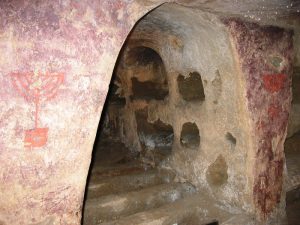CULTURE Catacombs of Venosa, the Italian Government’s Commitment
Mibact, the Italian Ministry for Cultural Heritage and Activities, has granted material aid to value old evidence of Jewish presence in Italy, one that is not very famous, but could tell a lot. €2.5 million is the sum the Government has given for the Jewish catacombs of Venosa, evidence for the great presence in the area between the 3rd and 7th century. It was the new mayor of Venosa, Marianna Iovanni, who announced this commitment; she intervened yesterday at a meeting about the site and the projects for making it more known, held in Rome, in the seat of UCEI Bibliographical Centre and organized by the Italian Jewish Heritage Foundation together with the association Daniela Di Castro.
As said by the President of the Foundation Dario Disegni, who opened the meeting, Venosa represents the greatest effort in terms of projects and resources, being also marked by the activation of a scholarship which allowed to create a presentation video recently broadcast by Rai (Italian national television). “It is an extraordinary site, but we still can’t use it much. For a year now there has been a very positive dialogue with the local Superintendence and Administration. That of today is a new step in an intense work in progress” underlined Disegni.
“Venosa community feels the responsibility of the role the history has given us. Here you will always find an open door” said then mayor Iovanni. It was her who walked minister Alberto Bonisoli through the visit at the catacombs in the near archaeological Roman complex on March 12th. The visit left a mark, so that he stated: “Venosa is an exceptional site, rare in Europe”. And tourism-wise speaking it has all the possibilities “to be another Pompei”. Thus, as soon as he learned about the election, said the mayor, “the minister called me to give me the news of the allocation”.
Great news for Guido Coen as well, UCEI council member and president of the association Daniela di Castro, who presented this new partnership, born with the aim of treasuring Jewish culture in the name of one of its greatest and never forgotten protagonists. “Southern Italy – Coen affirmed – is a mine of testimonies to be discovered and made known”.
The same satisfaction was also expressed by Sabrina Mutino, who intervened in the name of the Superintendence for Archaeological Heritage of Basilicata and noted “the special consideration” paid to the catacombs of Venosa explaining that the public funding “will be of use mainly for their preservation”.
Renzo Funaro, vice-president of the Foundation, took then the floor speaking about the “initiatives for Jewish Venosa 2020”. All of this, he reminded, was born in a conference in 2009. The start of this path has brought to a collaboration, the benefits of which were seen also at the first exhibition held at the Museum of Italian Judaism and the Shoah in Ferrara, where a focus was dedicated to Venosa. “The catacombs deserve an ever more international interest – for the meaning of the history they witness, for the symbols and the charm they evoke” Funaro said.
What do we know today about the Jewish presence in Venosa in those ages? The reconstruction comes thanks to professor Giancarlo Lacerenza, science chief of the project, together with Maurizio Lazzari, from CNR (the Italian National Research Council), who traced the environmental and occupational context with a regard for research prospects, and Vito Muscio, from geoNature, who presented new techniques of survey and fruition.
“Most of the data we need to reconstruct what was Jewish Venosa are already there, ready for us. A detailed study of historical research is fundamental, if we want some stories to tell. In this regard, virtual reconstruction too has had and will have a key role. It is a huge and necessary work” acknowledged Lacerenza.
Closing the summit, some thoughts of former Superintendent Maria Luisa Nava, with whom a dialogue started some years ago and who expressed her own satisfaction for the level and the results this communication among different bodies has achieved.
Translated by Rachele Ferin, student at the Advanced School for Interpreters and Translators of Trieste University, intern at the newspaper office of the Union of the Italian Jewish Communities.

